Peking University, May 17, 2013: “The major similarity between science and literature lies in the common concern for the world, and that both are fundamental elements of the environment we live in,” said Nobel laureate Chen Ning Yang ’42 during a talk at Peking University (PKU/Beida) on May 15.
“Science is closely related to philosophy and even religion,” said Yang. “To some degree science is limited because of limited human neurons for exploring the world, while religion has opened up an infinite domain, offering innumerable possibilities.”
With the theme “A Talk between Science and Literature,” the PKU School of Chinese Drawing and Painting invited two Nobel laureates, physicist Yang and writer Mo Yan for a dialogue.
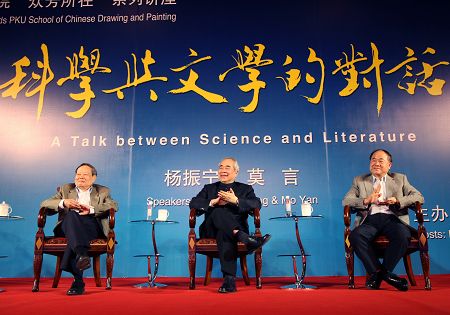
The talk
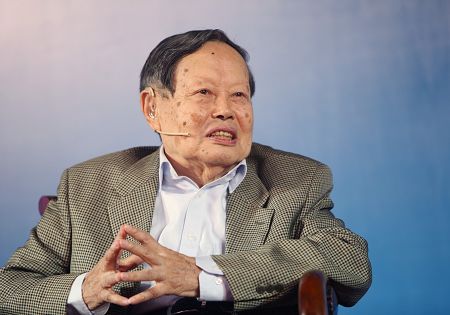
Chen Ning Yang
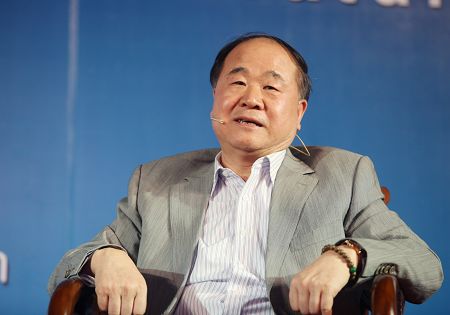
Mo Yan
When it comes to the difference, Mo, the 2012 Nobel laureate in literature said: “Science tends to use scientific theorems to explain the world; however, literature is based on ordinary lives, plus the feeling and thinking thereof.”
Science and arts share a responsibility: “Scientists and writers both seek to better understand the world, though from different perspectives,” said PKU President Wang Enge in the welcoming speech.
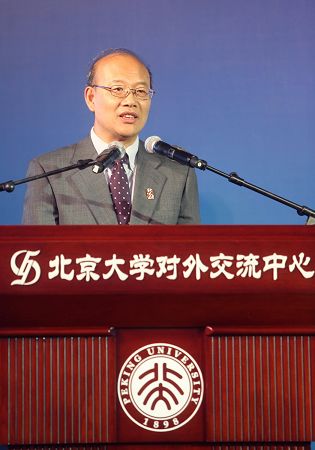
PKU President Wang Enge
Zhang Yuliang, dean of the School of Chinese Drawing and Painting, further explained: Science offers a possible setting for literature; on the other hand, literature broadens the scientific imagination.
Yang, the 1957 Nobel laureate in physics, put forward a “trilogy of research”: Great works or scientific achievements could only be accomplished through true emotion and sudden understanding.
The two guests also shared with the audience their personal experience. Mo considered himself as a storyteller. He said though he quitted school early, the childhood love for stories and countryside experience inspired him to keep on writing stories that mirror authentic country life. Being able to write great works that move people, move the world and even beyond the limitation of time and space remains his lifelong pursuit.
To encourage the young, Yang recalled his hard time in looking for research subjects when at the University of Chicago. “Never to give up while climbing the peak of science,” said Yang. “With belief and hard work, it will eventually pay off.”
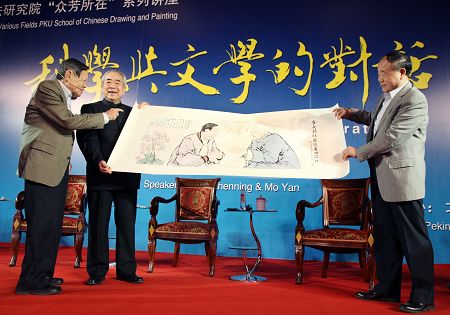
Moderator Fan Zeng (L2) presenting a gift
Video (Source: Caixin.com)
Fan Zeng, moderator of the event and director of the PKU Academy of Chinese Painting Research, asked the two guests to summarize the “Chinese dream” in their own languages. Yang said that could not be summarized in a single sentence or two, but he was optimistic about China’s scientific and technological development, and the Chinese dream would be realized.
Mo, however, continued his “hallucinatory realism”: “I recently read a piece of information on the Internet: a US company is recruiting the first batch of volunteers to migrate to the Mars. People from China constitute the largest applicant pool.”
“I think it is an expression of a dream: to go up to the sky,” said Mo.
Background Info:
Guan Moye (pen name: Mo Yan, born 1955), a Chinese novelist and short story writer, is best known to Western readers for his 1987 novel Red Sorghum Clan, which was later adapted for the screen. In 2012, Mo was awarded the Nobel Prize in Literature for his work as a writer "who with hallucinatory realism merges folk tales, history and the contemporary."
Chen Ning Yang (pinyin: Yang Zhenning, born 1922) is a Chinese-born American physicist who works on statistical mechanics and particle physics. Yang obtained his BS in 1942 at the then National Southwest Associated University, jointly formed by Peking, Tsinghua, and Nankai Universities. He and Tsung-dao Lee received the 1957 Nobel Prize in Physics for their work on parity nonconservation of weak interaction.
Written by: Zheng Ye
Edited by: Jacques
Source: PKU News (Chinese)